Aside from vintage year, pu-erh tea can be classified in a variety of ways: by shape, processing method, region, cultivation, grade, and season.
Pu-erh is compressed into a variety of shapes. Other lesser seen forms include, stacked "melon pagodas", pillars, calabashes, yuanbao, and small bricks (2-5cm in width). Pu-erh is also compressed into the hollow centers of bamboo stems or packed and bound into a ball inside the peel of various citrus.
| Image | Common name | Description |
|---|
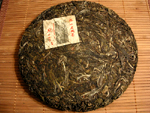 | Bing, Beeng, Cake, or Disc | A round, flat, disc or hockey puck-shaped tea. Size ranges from as small as 100g to as large as 5 kg or more, with 357g, 400g, and 500g being the most common. Depending on the pressing method, the edge of the disk can be rounded or perpendicular. Also commonly known as Qizibingcha ( literally "Seven units cake tea") because seven of the bing are packaged together at a time for sale or transport |
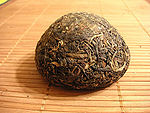 | Tuocha, Bowl, or Nest | A convex knob-shaped tea with size ranging from 3g to 3 kg or more, with 100g, 250g, 500g being the most common. The name for "tuocha" is believed to have originated from the round, top-like shape of the pressed tea or from the old tea shipping and trading route of the Tuojiang River.In ancient times, tuocha cakes may have had holes punched through the center so that they could be tied together on a rope for easy transport. |
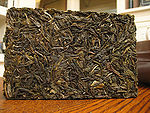 | Brick | A thick rectangular block of tea, usually in 100g, 250g, 500g, and 1000g sizes. Zhuancha bricks are the traditional shape that was used for ease of transport along the Ancient tea route by horse caravans. |
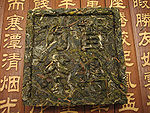 | Square | A flat square of tea, usually in 100g or 200g sizes. They often contain words that are pressed into the square. |
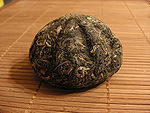 | Melon, or Gold melon | A shape similar to tu¨®ch¨¢, but larger in size with a much thicker body that is decorated with pumpkin-like "stripes". This shape was created for the famous "Tribute tea" that was made expressly for the Qing Dynasty Emperors from the best tea leaves of Yiwu Mountain. Larger specimens of this shape are sometimes called "Human-head tea" due in part to its size and shape, as well as the fact that in the past it was often presented in court in a similar manner to severed heads. |
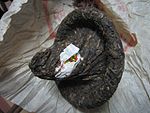 | Mushroom | Literally meaning "tight tea," the tea is shaped much like t¨²ocha, but with a stem rather than a convex hollow. This makes them quite similar in form to a mushroom. Pu-erh tea of this shape is generally produced for Tibetan consumption, and is usually 250g or 300g. |





